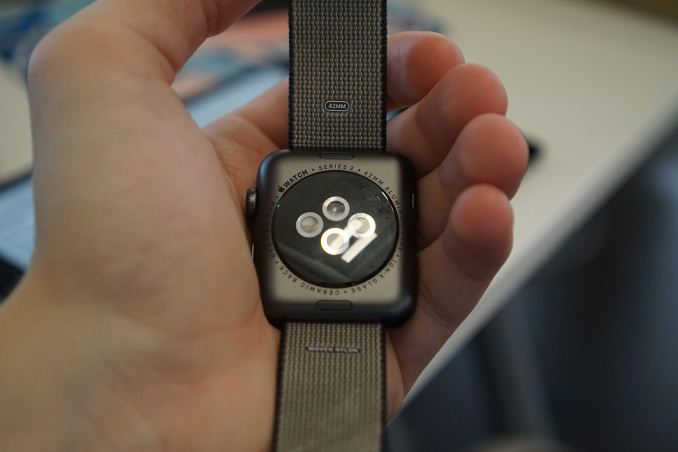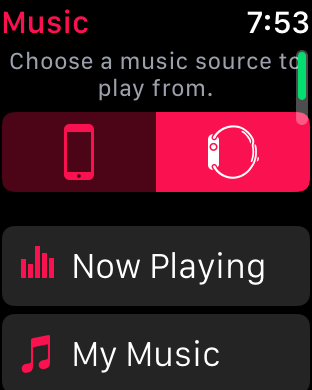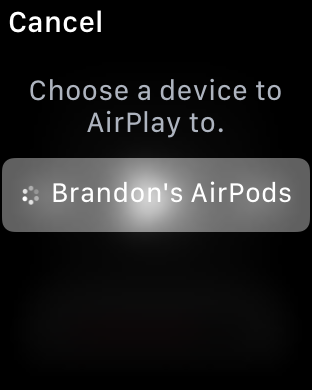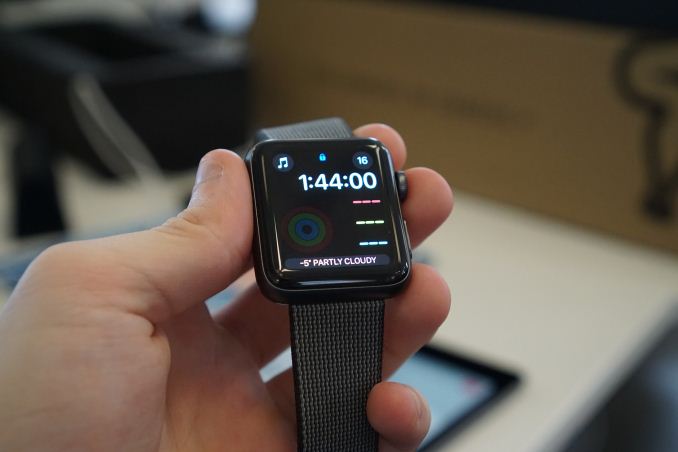The Apple Watch Series 2 Review: Building Towards Maturity
by Brandon Chester on December 20, 2016 8:00 AM EST- Posted in
- Wearables
- Apple
- Apple Watch
- Apple Watch Series 2
Final Words
In many industries, but especially in technology, there's a common wisdom about waiting for the second or third iteration of a product before purchasing it. This is based on the idea that the first version of a product will often be the most flawed or compromised - a product still trying to find its footing - and future iterations will benefit from improved technology, as well as fixes for flaws that were found in early versions. At the same time, there have to be some people who are adventurous enough to adopt bleeding-edge technology, or the first version of a product would simply fail in the market and there wouldn't ever be a second version.
This situation has played out for every iOS and iOS-derived device that Apple has created. The original iPhone was quite a technological marvel, but it was crippled by its lack of 3G networking, and its price was exceptionally high. With the iPhone 3G and 3GS, Apple addressed many of the issues that existed with the iPhone 2G, and by the time of the iPhone 4 the refinement was essentially at the same level that we expect from smartphones today. The original iPad was an interesting idea, but it was quick thick and heavy, and the hardware used at the time was not up to the task of powering such a device, sending it to end of life status after only two major updates. Only one year later, the iPad 2 addressed both of these issues, future versions brought faster hardware and higher resolution displays, and by the time of the iPad Air it reached a level of refinement where further versions have been much more iterative changes.
The first Apple Watch was definitely in the same situation as the iPhone 2G and the iPad 1. It was the first version of a brand new product, bound by serious hardware limitations and many unknowns about how consumers would come to use it. Like the iPad 1 it has received two major OS updates, and I don't expect it to go any farther. I talked earlier about how Apple had an idea of how the Apple Watch would be used, but clearly overestimated the appeal of some aspects and underestimated the appeal of others. The Apple Watch Series 2 focuses more on these aspects such as fitness with its GPS and true waterproofing, while watchOS 3 fixes many of the software issues that existed in the previous two versions.
The Apple Watch is still very much a companion to the iPhone. Even with the addition of GPS, it isn't close to being able to stand on its own. You can avoid bringing along the paired iPhone for workouts, and the watch can pull data from the network in some cases using its built in WiFi, but in general having the iPhone nearby is a requirement to actually do anything. Bringing cellular to the Watch would make it significantly less-dependent on the iPhone, but that also comes with a power and a space penalty, both of which are heavily constrained with a smartwatch.
Even if Apple were to bring cellular to the Apple Watch, I question how beneficial it would be for the experience given the two drawbacks I mentioned above. I can't think of many cases where I don't actually have my phone, so I don't know why I'd pay to maintain an additional cellular line for my watch when my phone was usually available to handle network activity. Additionally, adding cellular wouldn't remove the tight connection between the two devices, as the Apple Watch's settings and backups exist on the paired iPhone, and all of its applications are extensions of iPhone apps. This model makes it clear to me that Apple isn't planning to make the Apple Watch a standalone device any time soon.
As a companion to the iPhone, the Apple Watch works quite well. For me the Apple Watch is a timepiece, a hub for relevant information and notifications, a music player, and a health and fitness tracker. I've long since gotten used to having something on my wrist, and in fact I find myself checking my bare wrist out of habit when I've taken the Apple Watch off. Being able to check the time, the weather, the date, and other information simply by raising your wrist is just a convenience, and it's nothing your iPhone can't do as well, but it's a convenience that I wouldn't want to give up now that I have it.
Using Apple Watch as a music player is probably a more niche use case, but it does apply to me. It really seems like the natural replacement of the current iPod Nano, which is of a similar size. Of course, there's no headphone jack, but I've been using Bluetooth headphones for seven years so that doesn't present a problem for me personally. Even if you use your iPhone for music, the Apple Watch provides a quick way to access playback controls, especially if you have the Music application set as a complication or kept in the Dock. I suspect that more users will end up utilizing the standalone Music playback abilities of the Apple Watch now that the AirPods are shipping to consumers, but only time will tell.
Last, but not least, are the Apple Watch's health and fitness tracking abilities. When the Apple Watch first launched I thought I would just turn these off and forget about them, but my own poor health choices have led to me relying on them to keep myself on track. Having something constantly monitoring me is essential in figuring out how many calories I'm burning on a daily basis, which is how I decide what I'm going to eat. Workouts also provide me with various statistics about my jogging and cycling that I had always wondered about but had never been able to track. As the days get colder, having the Activity rings on the watch face is also a constant reminder that I need to keep active even if I'm staying inside to keep warm. Many of these things basically come down to the Apple Watch pointing out flaws in my personality that I won't improve of my own volition, and I'm okay with that because it produces results.
While I'm talking about the core aspects of the current Apple Watch experience, it does bear repeating that some things that Apple thought would be a big part of the experience have really fizzled out. I haven't found myself using it as a communication device except for taking phone calls, and Apple has de-emphasized communication as a feature in watchOS 3 accordingly, so I expect I wasn't alone. Similarly, I think issues with watchOS and the original Apple Watch's hardware have damaged the image of the Apple Watch as an app platform, and as someone who used the original I really haven't gotten used to using applications because in the past they just never worked.
As for development, I think it's fair to say that the Apple Watch hasn't yet proven itself as a developer platform. However, WatchKit is a really interesting and well thought out API for designing and developing apps for the smartwatch form factor. Despite the quality of the API itself, there's clearly still uncertainty over what an Apple Watch app should even aspire to do. I think not making a watchOS app at all is a valid decision for many iPhone applications, and that's an important decision for developers to make because it's an investment of time and money, and there are several applications that offer watchOS apps without any compelling functionality.
Ultimately, both watchOS and the Apple Watch are still in their early days, and the software will grow and improve over time as the hardware becomes faster and more efficient. The Apple Watch Series 2 really reminds me of the iPad 2. It tackles the areas where its predecessor faltered, and provides a much better experience as a result, but there's still that lingering early adopter feeling that even greater improvements are coming in the next generation. I would imagine that future series of the Apple Watch will bring additional sensors for tracking health information, thinner casings, and hopefully better battery life so features like sleep tracking will be possible. While there's always something to look forward to in future versions of a product, I think the Apple Watch Series 2 does provide a compelling experience right now, and for iPhone users interested in a fitness tracker or a smartwatch it should be high on your list of devices to consider.















126 Comments
View All Comments
Alexey291 - Friday, December 30, 2016 - link
But most of them wore a watch.That's the thing. The world IS changing. Constantly. The watches are on the way out. Have been for a long time.
sorten - Tuesday, December 20, 2016 - link
BTW, they only sold 1.6M in the second quarter.https://www.idc.com/getdoc.jsp?containerId=prUS416...
name99 - Tuesday, December 20, 2016 - link
AKA the quarter when everyone was waiting for the next release...Not very interesting. ESPECIALLY for the early adopter phase of the lifecycle, when EVERYONE who bought an Apple watch is keenly following when the next one will come out.
Compare with iPhone 1 first year:
https://www.statista.com/statistics/263401/global-...
fanofanand - Wednesday, December 21, 2016 - link
I don't know how much Apple is paying you to troll (I suppose iSheep do it for free) but watches and phones are VERY different markets.name99 - Wednesday, December 21, 2016 - link
Christ you are blind.A "phone" is a pocket computer. A "watch" is a wrist computer. An Airpod is an in-ear computer.
They're all damn computers, they'll gain functionality (and desirability) with the inevitable march of time.
You guys like to ha-ha about stupid Thomas Watson and his "market for five computers" or stupid Ken Olson and his "no reason anyone would want a computer in their home" but you think in EXACTLY the same way --- and with 70/40 more years experience you have a hell of a lot less of an excuse.
goatfajitas - Thursday, December 22, 2016 - link
Shave that neck son.fanofanand - Thursday, December 22, 2016 - link
When you cannot provide logic I guess you resort to name-calling. Either he is the most die-hard dyed in the wool Apple supporter or he's receiving checks out of Cupertino.FunBunny2 - Thursday, December 22, 2016 - link
-- They're all damn computers, they'll gain functionality (and desirability) with the inevitable march of time.sure. if they plug into a wall socket and have big screens. wearables, of any kind, fail on both counts. batteries have not had, and have no foreseeable, order of magnitude increase in power density in many decades. as SEC filings say, past performance is no indication of future results.
BrokenCrayons - Tuesday, December 20, 2016 - link
I generally agree with the consensus that wearable tech devices don't have much momentum left at this point. Three of my coworkers purchased fitness bands and smart watches. Two of them quit wearing them after a couple of months. The third is planning keep this smart watch for the time being, but isn't certain a replacement is worth the trouble. Outside of my one remaining holdout coworker, I don't even know anyone that wears a watch of any sort and I haven't seen a smart watch in the wild outside of one of my coworkers.Ikepuska - Tuesday, December 20, 2016 - link
I would say that certain industries tend to wear watches more than others nowadays, outside of the high end or collector market. I can tell you that where I currently work, everyone I know wears watches. But we also work outside a lot, work long hours and need to keep track of time the whole way through. I also have a few co-workers who collect watches. Of the two that I know how much they've spent, one has about 30k, another almost 100k invested in watches. Admittedly these are collections built over 10+ years. So I suspect that watches are a bit like physical books. Certain industries buy them more than others, and there are a few people who spend the vast majority of the money.